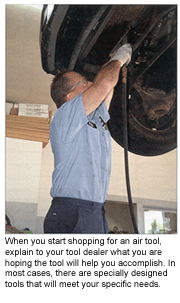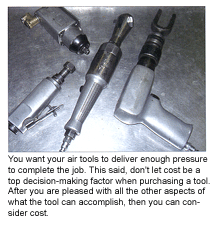Those two words say a lot when speaking about air tools. The first and most obvious is that air tools need pressure to operate properly. Everyone knows that with enough air pressure you can make any air tool do the job you want it to do, right?
Another way of looking at these two words is: “under” pressure; as in not enough pressure. Just to make things interesting, is it pressure or volume you need? Well, the answer is both.
 So, what is important when shopping for air tools? While this answer will be different for lots of folks, here are some issues that I think are important to everyone.
So, what is important when shopping for air tools? While this answer will be different for lots of folks, here are some issues that I think are important to everyone.
Application – Where, how and for how long will the tool be used?
Ergonomics – Do you or your job require special design features?
Physics – I know, this is just an air tool, right? Well, yes and no … we need to talk about a simple relationship between pressure and volume.
Cost – You notice I listed this last? This should be the last thing you think about after you are happy with all the other aspects of the tool.
Application
What do you need your new air tool to do? Remove 1-1/8″ Budd wheel sockets on a dually with a torque of 185 ft.-lbs.? Tighten the retaining nuts on a circuit board of an electronic control unit that are 1/4″ in diameter? Spin a cutoff wheel at 20,000 rpm for minutes on end? How about drive a needle scale attachment to scrape rust off the inside of a ship’s hull for hours at a time.
I know these examples are a little silly, but I hope it illustrates my point. We expect our air tools to do these tough jobs, yet we pick tools without thinking about the job to be done. When you start shopping, tell your tool dealer what you are going to do with the tool. In most cases there are specially designed tools to do just what you want it to do. Ergonomics
 This is just a big word for being comfortable and not causing injury. Do you work in a high volume tire shop? When the service writer throws four tires out the window and says “58 minutes and counting …, ” do you cringe?
This is just a big word for being comfortable and not causing injury. Do you work in a high volume tire shop? When the service writer throws four tires out the window and says “58 minutes and counting …, ” do you cringe?
The last thing you need to worry about is the air gun being too heavy or too hard to hold on to. That is what ergonomics is all about. Make sure the tool feels good in your hand. If it feels awkward on the truck, it is not going to get any better in the service bay! Everybody is different on this issue. Make sure the tool fits you.
Physics
OK, I know that you didn’t ask for a school lecture here, so I will keep this short and simple – I hope! Air tools are dependent on two things to operate to their full capacity: pressure and volume. I know that you know all about this, so just bear with me while I explain it to that other person.
All air tools are nothing more than air motors; they need the right input of air in order to do the work they were designed to do. Pressure is like the tightness in a balloon. While this is important, there is another factor – volume, which is equally important. Think of volume as the ability of your great uncle Charley to blow out all 50 of the candles on his birthday cake without taking a second breath! In the tool business we frequently deal with returned tools due to this very issue. Volume, or the lack of it, can make even the best tools under-perform. Volume is a tricky thing. You’ve heard that a chain is only as strong as its weakest link? This is true of air volume in a shop air system. The only difference is that the system is only as good as its smallest link.
What am I talking about here? Fittings, hose diameter, connectors, plumbing – all of these can cause problems with your air tool not performing to its abilities.
If you are going to invest in that high power macho 600-lb. impact wrench, don’t skimp on the fittings and air hose to support it properly! The tool needs a lot of volume to create that power you paid for.
Cost
Like all things in life, you tend to get what you pay for. Now I am not saying that all expensive air tools are good and all inexpensive air tools are bad.
The reality is that overall, the quality of tools in general, and air tools specifically, has gotten better in the last few years. The point here is cost is relative to your needs and expectations. If you are in an industrial setting operating in a harsh environment on oversize fasteners, then by all means spend that extra $100 to make sure you get the very best. On the other hand, if you are the average tech who needs good reliable tools, then spend some extra time making sure you have the correct fittings, supply hose and compressor.
Hopefully this will help eliminate the pressure you feel when deciding what air tool you are going to buy next time.
|
Air Drying Filters Protect Air-Powered Tools from Rust and Corrosion
Removal of free water is a major concern in compressed air applications, such as impact wrenches and other air-powered tools, because water accelerates rust and corrosion. For most applications, air drying filters are among the best solutions for removing water and reducing damage to tools and equipment. In most cases, expensive water removal equipment is only marginally better at removing water than the best filtration systems, which cost significantly less. “Rust and corrosion are the largest contributors to compressed air tool and equipment failure,” says Chris Greeson, senior technical services manager for WIX Filters. “Using a filtration system to remove as much water as possible is a very cost-effective solution that can greatly improve the life of air-powered tools and equipment.” Today’s air drying filters are simple to install and use. These filters utilize an absorbent media housed inside a protective casing, with a look similar to that of a car’s oil filter. Many are made as spin-on filters that are as easy to change as any spin-on automotive oil filter. After passing through air drying filters, relative humidity in the air that enters power tool applications is reduced significantly. Greeson recommends multi-stage filtration in compressed-air applications. This means having more than one filter in the system to capture water vapor that condenses downstream from the first filter. “No solution, short of freezing water below -35° F, can fully prevent water vapor,” Greeson says. “But multi-stage filtration employing two or more filters can remove most water vapor and keep tools and equipment running smoothly.” Courtesy of WIX Filters. |
